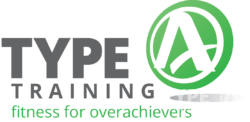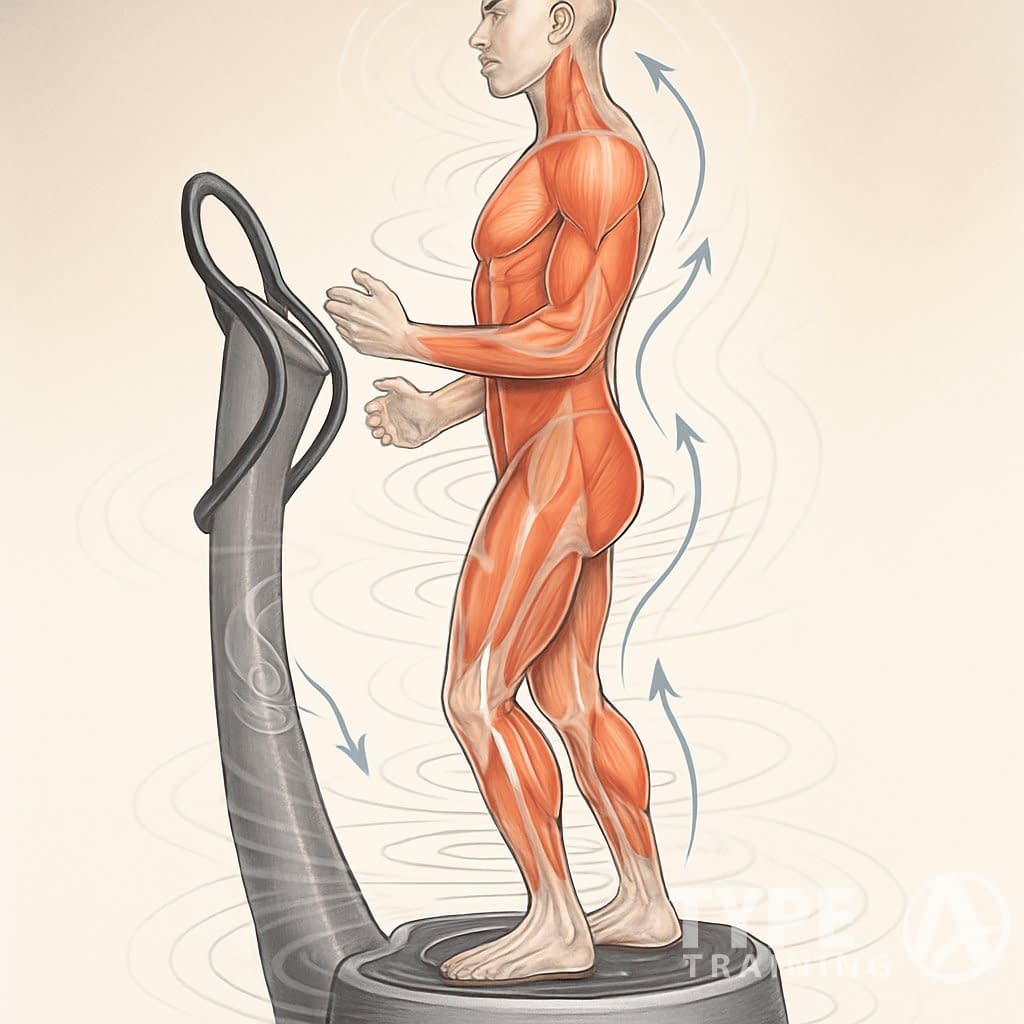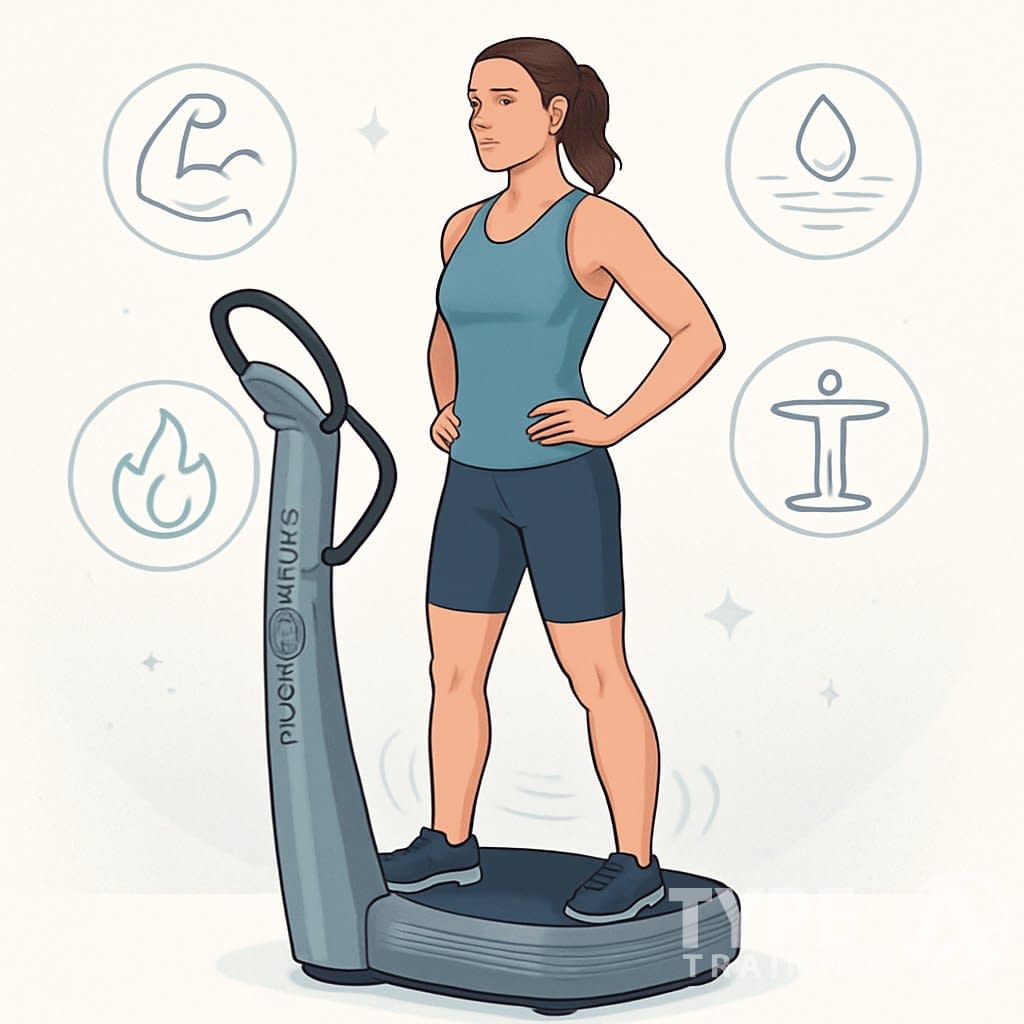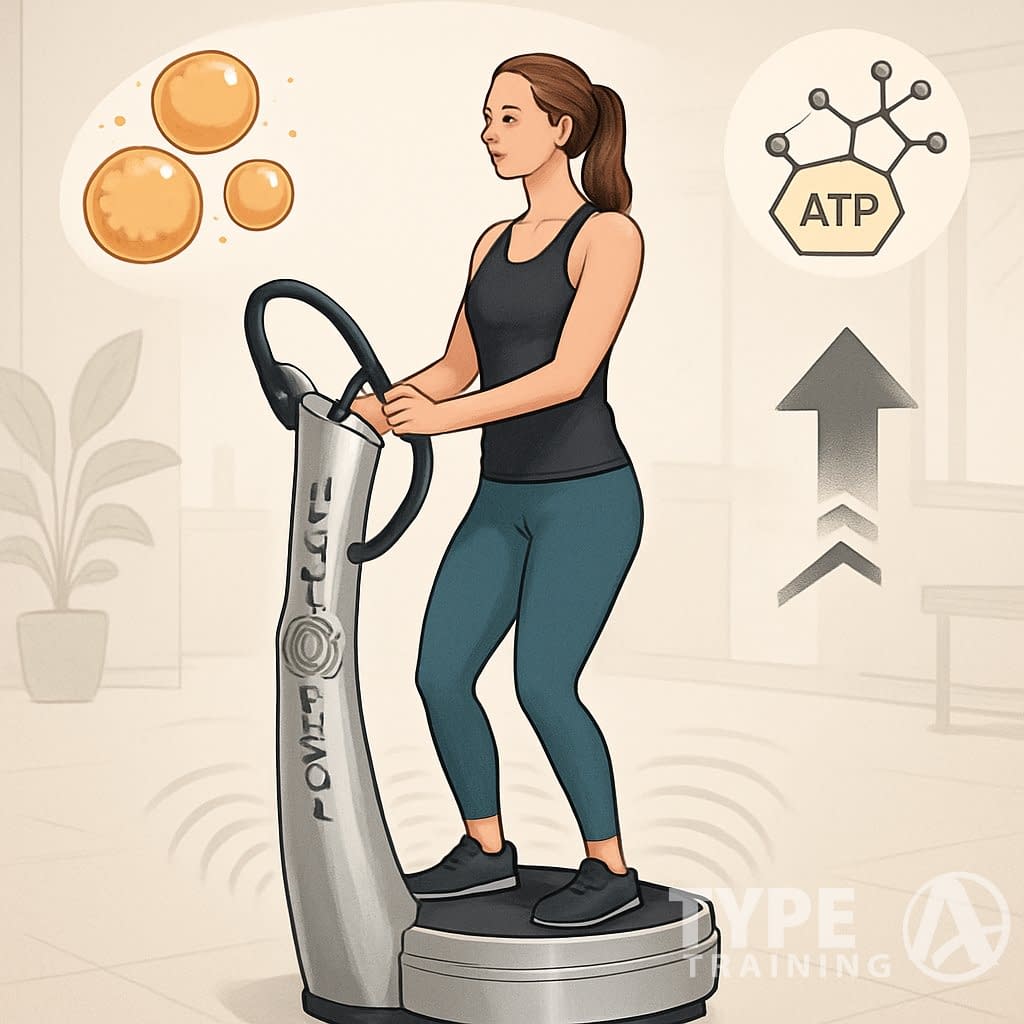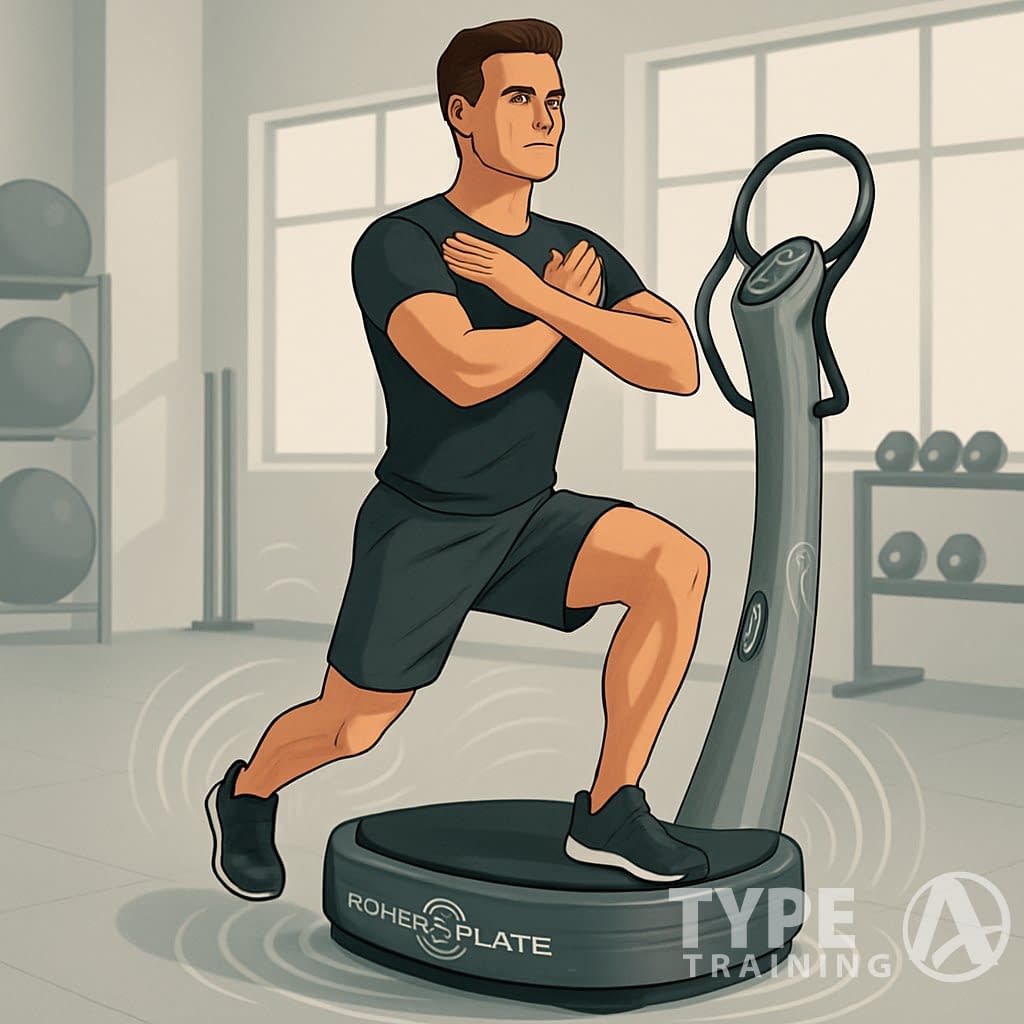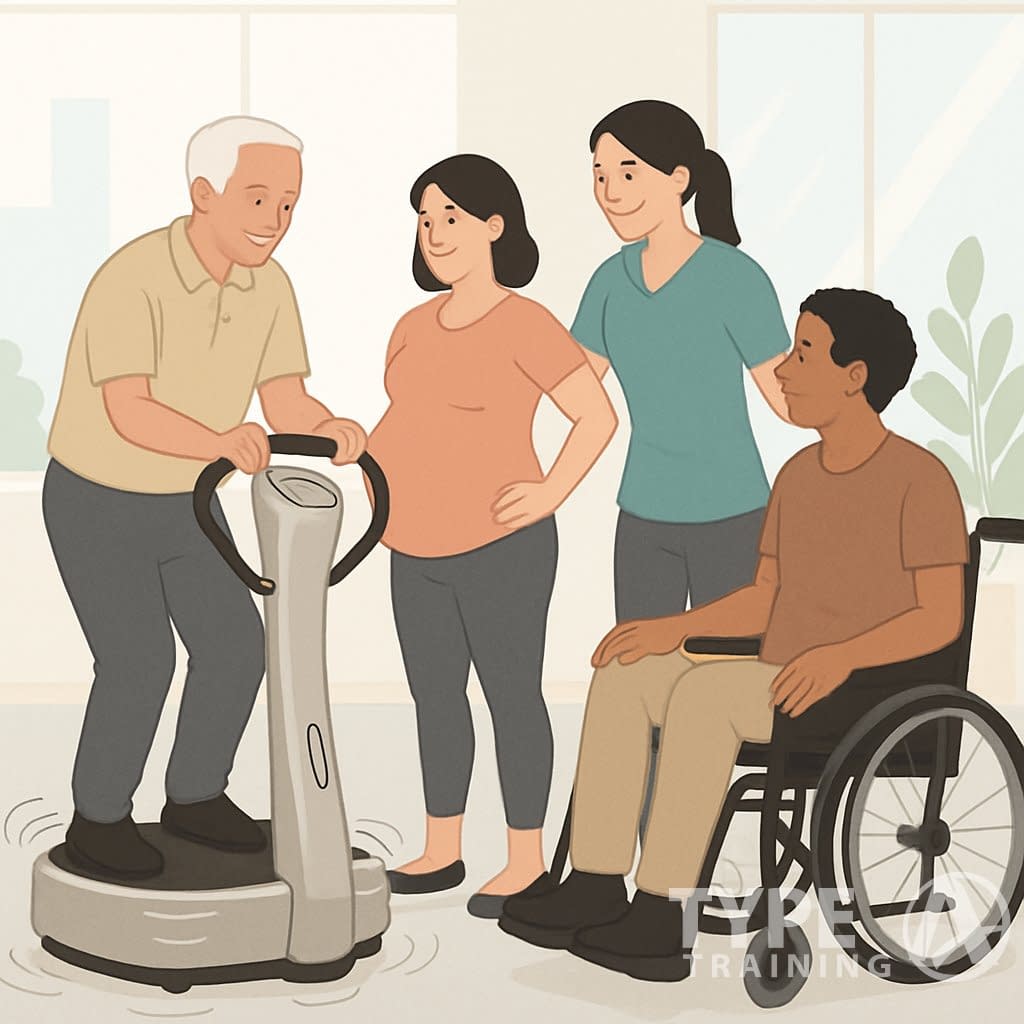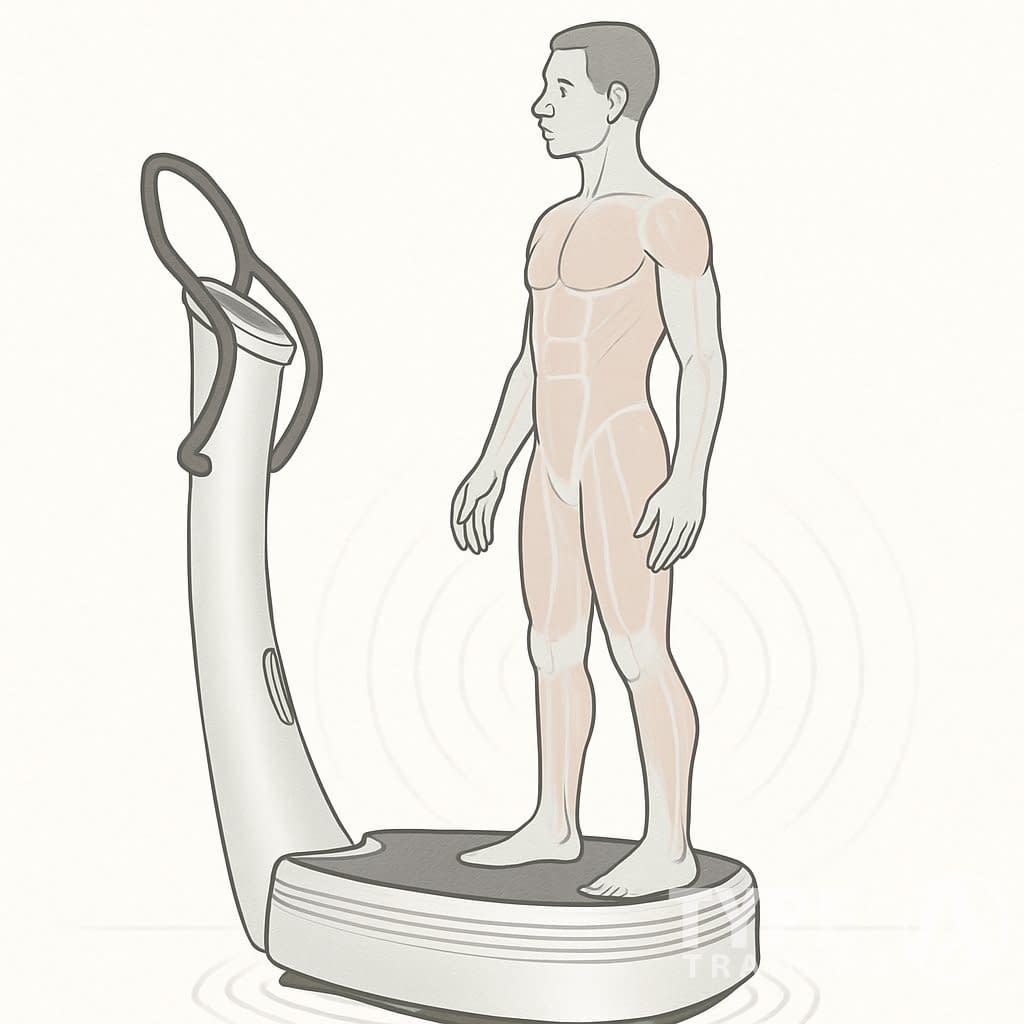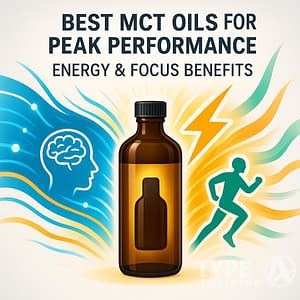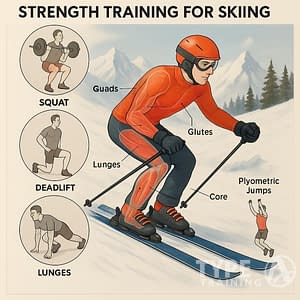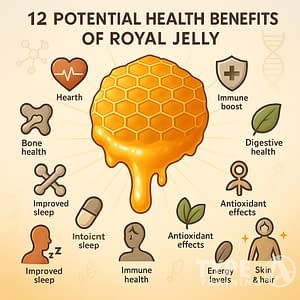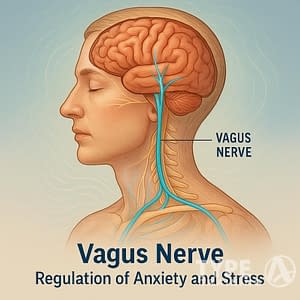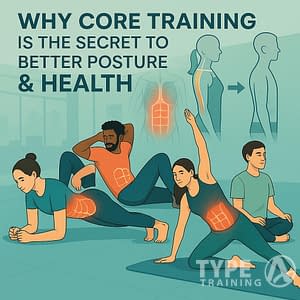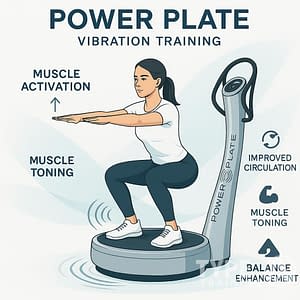A Power Plate is a whole-body vibration machine that uses rapid vibrations to stimulate your muscles. It makes your muscles contract and relax many times per second, so your body works more muscle fibers than in a typical workout.
This technology aims to enhance strength, improve balance, and support circulation in less time than traditional exercise.
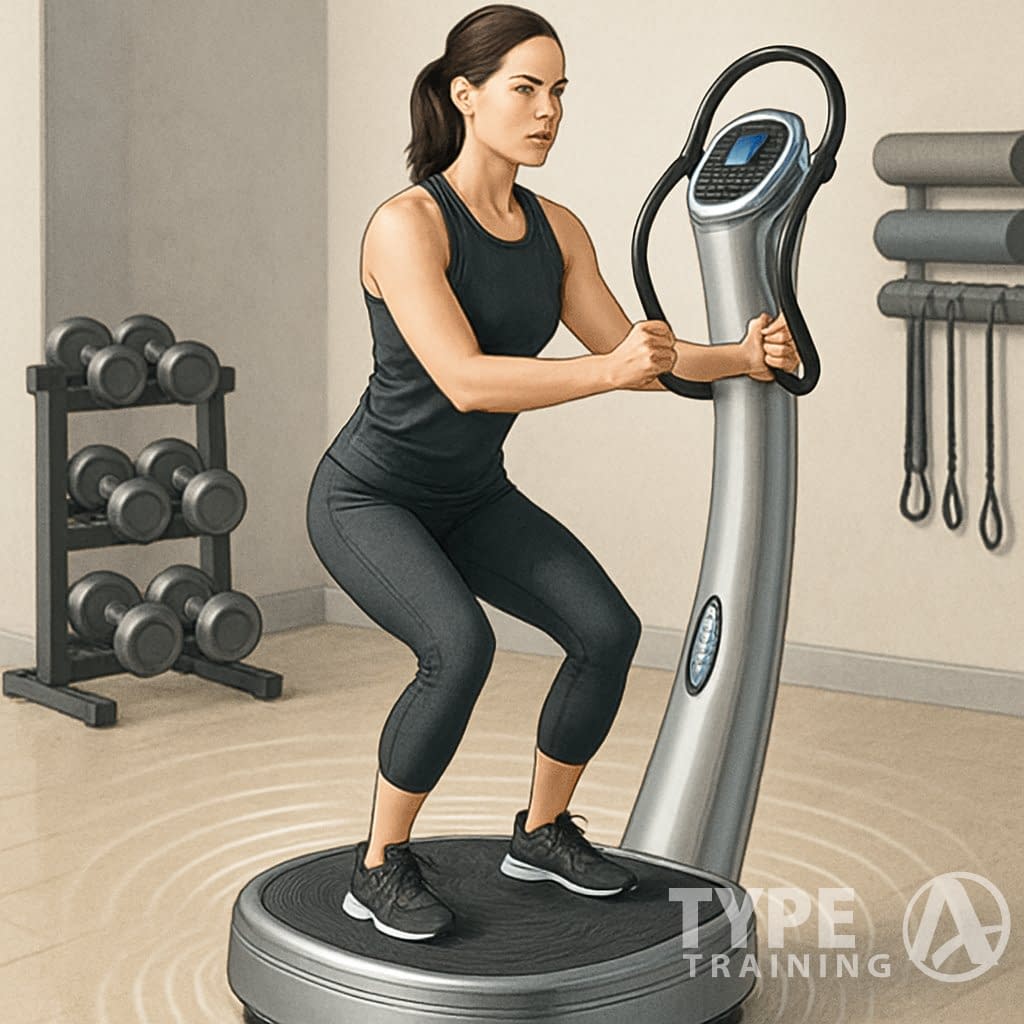
When you stand, sit, or do exercises on the platform, it moves in multiple directions at high speed. These vibrations challenge your muscles to stabilize you, so even simple movements can feel more intense.
Popular posts:
You might notice benefits like better flexibility or faster recovery after a workout.
Whole-body vibration training targets several systems in your body. People use it in fitness, rehab, and even for bone health.
If you want to save time, add variety, or just try something new for overall wellness, it’s a practical option to consider.
Key Takeaways
- A Power Plate uses vibrations to activate more muscle fibers during exercise.
- Whole-body vibration training can support strength, balance, and circulation.
- This method offers fitness and wellness benefits for different goals and needs.
What Is a Power Plate and How Does It Work?
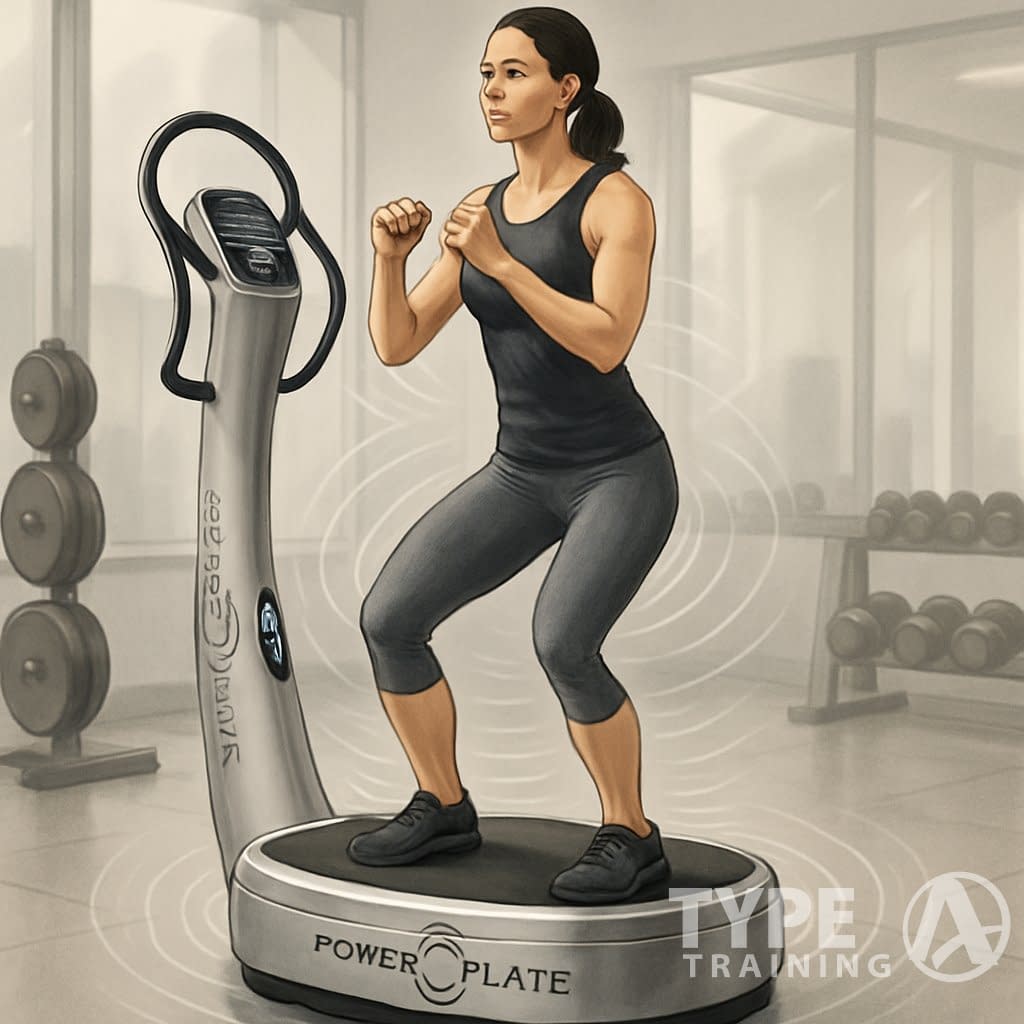
A Power Plate is a whole-body vibration machine that uses controlled vibrations to stimulate your muscles. Scientists first developed this tech to help astronauts keep bone and muscle health in space, but now you’ll find it in gyms, rehab centers, and wellness studios.
Definition of Power Plate and Vibration Platforms
A Power Plate is basically a vibrating platform you can stand, sit, or work out on. Unlike typical gym gear, it delivers whole-body vibration (WBV) to get more muscle fibers working during movement.
Vibration machines like this make your muscles contract and relax rapidly. This can boost muscle activation, balance, and circulation—especially if you pair it with standard exercises.
You can use a Power Plate for:
- Strength training with bodyweight or free weights
- Flexibility by stretching on the platform
- Rehabilitation to improve balance and mobility
- General wellness for bone density and circulation
The machine is pretty compact, so you can fit it in gyms, therapy clinics, or even your living room.
How Whole-Body Vibration Technology Functions
Whole-body vibration training (WBVT) sends rapid vibrations through you while you’re on the platform. These vibrations force your muscles to contract and relax many times per second.
Your body responds by firing up stabilizing muscles that usually get less attention in typical workouts. Research shows vibration training can activate more muscle fibers than traditional exercise.
The platform moves against gravity, so your muscles have to adjust with each vibration. This can help you build strength and stability pretty quickly.
WBV may also support bone health, mobility, and circulation. It’s not a total substitute for exercise, but it’s a solid addition to your routine.
Types of Vibrations and PrecisionWave Technology
Not every vibration platform moves the same way. The Power Plate uses tri-planar vibration—it moves up and down, side to side, and front to back.
This mimics natural muscle stimulation better than single-direction machines.
The platform uses PrecisionWave™ technology to deliver steady, controlled micro vibrations. That keeps the intensity stable and the workout safer.
Other vibration machines might use linear or oscillating movements, but tri-planar is usually more thorough for muscle activation.
You can dial the frequency and amplitude up or down. Lower settings are good for recovery or therapy, while higher ones challenge your strength and balance.
Mechanisms of Whole-Body Vibration Training
When you step on a vibration platform, the machine sends rapid signals through your body that trigger physical responses. These vibrations affect how your muscles contract, how your nerves communicate, and how blood flows through your system.
Muscle Activation and Contractions
A vibration plate creates quick movements under your feet or body. These vibrations make your muscles contract and relax over and over—way faster than you could do on your own.
Unlike regular exercise, where you control each movement, the platform forces your muscles to react automatically.
This activity pulls in more muscle fibers than standard movement. Both fast-twitch and slow-twitch fibers get involved, which can help build strength and endurance.
Even just standing with bent knees feels surprisingly tough.
All those contractions burn more energy in less time. Vibration training is efficient for muscle activation—no heavy weights needed.
Many people use it to supplement regular workouts or to keep muscles active during recovery.
Neuromuscular Responses and Reflexes
Your body reacts to vibration through something called the tonic vibration reflex. When the platform moves, sensors in your muscles and joints pick up the motion.
They send signals through your nervous system, which triggers rapid muscle contractions.
This reflex helps your brain and muscles coordinate better. Over time, it may boost balance, stability, and reaction speed.
For older adults or anyone in rehab, this can lower the risk of falls and make daily movement easier.
Your nervous system also learns to recruit muscle fibers more efficiently. Exercises on the plate can feel more demanding because your body is always adjusting to the vibrations.
This constant feedback makes the training more dynamic than just holding a pose.
Impact on Circulation and Blood Flow
Vibrations also affect your blood flow. As your muscles contract over and over, they act like a pump, helping move blood back to your heart.
This can improve circulation and get more oxygen to your working muscles.
Better circulation may help reduce muscle stiffness after activity. It can also clear out waste products like lactic acid faster, which supports recovery.
Some research even suggests vibration training might help reduce swelling by moving fluid around.
Improved blood flow can benefit your vascular health overall. By stimulating small blood vessels, vibration may help deliver nutrients to your tissues.
So it’s not just about strength—the platform can support recovery and general wellness too.
Key Health and Fitness Benefits
Whole-body vibration training with a Power Plate can support bone health, improve muscle strength, and help you move with more control.
These benefits make it useful for fitness and for lowering risks tied to aging and frailty.
Bone Density and Osteoporosis Prevention
Power Plate training can help you maintain or even increase bone density by applying mechanical stress to your skeleton in a safe, low-impact way.
The vibrations stimulate bone tissue, encouraging your body to preserve and rebuild bone mineral density.
This is especially important for postmenopausal women, who face higher risks of osteoporosis due to hormonal changes.
Better bone strength lowers the risk of fractures—a big concern for older adults.
Research points to regular vibration platform use as a way to slow age-related bone loss. While it’s not a replacement for weight-bearing exercise or good nutrition, it can be a helpful addition to your bone health routine.
Key points for bone health:
- Supports bone mineral density
- Helps prevent osteoporosis-related fractures
- Useful for post-menopausal women at higher risk
Strength Gains and Muscle Mass
When you stand, squat, or do exercises on the Power Plate, the vibrations cause rapid muscle contractions. This means you activate more of your muscle fibers than with traditional exercise.
Over time, you can see real strength gains and improvements in muscle mass.
People often use the platform to complement resistance training, especially if they want efficient workouts. It’s also helpful for older adults who can’t lift heavy but still want to keep their muscle strength up.
More muscle mass supports better mobility, lowers frailty risk, and helps you stay independent as you age.
Even short sessions a few times a week can make a difference in muscle function.
Benefits for muscle health:
- Engages up to 95% of muscle fibers
- Promotes strength gains and muscle mass
- Supports mobility and independence in older adults
Balance, Stability, and Coordination
The Power Plate challenges your postural control by creating small, constant shifts in your position.
Your muscles and nervous system have to react quickly, which can improve balance, stability, and coordination.
This training is especially valuable for lowering fall risk. Falls cause many injuries in older adults, usually due to poor balance or slow reflexes.
Practicing on a vibration platform trains your body to react better to sudden movements.
Better coordination isn’t just for seniors—it can sharpen athletic performance too. Whether you’re recovering from injury, managing age-related changes, or just want to move better, this kind of training is worth a look.
Balance-related benefits:
- Enhances postural control
- Reduces fall risk in older adults
- Improves coordination for daily activities and sports
Weight Management and Metabolic Effects
Whole-body vibration training can help with weight management by boosting calorie burn, reducing certain types of body fat, and supporting metabolic health.
How much it helps really depends on how often you use the Power Plate, how hard you work, and whether you combine it with a healthy diet and other exercise.
Weight Loss and Fat Reduction
Standing, squatting, or exercising on a Power Plate makes your muscles contract over and over, which burns more energy. You’ll likely burn more calories in less time than with static exercise.
Research shows that regular use may help lower body mass index (BMI) and body fat percentage. These changes show up best when you combine vibration training with other activity and good nutrition.
You shouldn’t expect weight loss from vibration alone. It works best as a tool to make your workouts more efficient, not a replacement for movement or healthy eating.
Visceral and Adipose Fat
Not all body fat is the same. Adipose fat sits under your skin, while visceral fat builds up around your organs.
Visceral fat is more strongly tied to health risks like insulin resistance and heart disease.
Some studies suggest vibration training may help reduce both subcutaneous and visceral fat if you use it regularly. The mechanical stimulation boosts circulation and muscle activity, which can encourage fat breakdown over time.
You might notice the biggest changes around your midsection, where visceral fat collects. But results vary a lot from person to person and depend on your overall lifestyle.
Pairing vibration training with a balanced diet and aerobic exercise gives you the best shot at real fat loss.
Support for Healthy Metabolism
Vibration training can really boost your metabolism. Those rapid muscle contractions activate more muscle fibers than you’d get with most traditional exercises, so your metabolic rate jumps during and after the workout.
Your body starts using glucose and fats for fuel more efficiently as energy demand increases. Over time, this might help with weight management and lower your risk for issues like insulin resistance.
It’s smart to combine Power Plate sessions with strength training, some cardio, and a diet full of nutrients. That mix gives your metabolism the best shot at long-term health.
Applications, Exercises, and Practical Use
You can use a Power Plate to build muscle, get more flexible, and recover faster after tough workouts. It pairs well with classic moves and can also help with circulation, joint comfort, and posture.
Common Power Plate Exercises
Most traditional exercises work on a Power Plate, but the vibration cranks up muscle activation. Squats, lunges, planks, and push-ups are some go-to moves. Each one recruits more muscle fibers than if you were just on the floor.
For extra challenge, try adding resistance bands or weights while standing on the plate. You get more out of your workout without needing extra time. Athletes often use this to build strength and endurance.
Interval training fits right in too. Maybe you do 30 seconds of squats, take a short break, then switch to push-ups or planks. These bursts can boost your aerobic fitness and stamina. The platform keeps your muscles firing even when you pause, so you get more out of each session.
Flexibility, Mobility, and Posture
The Power Plate can help with flexibility by relaxing tight muscles and getting blood moving. Try stretching your hamstrings or calves on the vibrating platform—it feels different and can help you loosen up over time.
Mobility moves like hip openers or shoulder rolls seem to work better on the plate. Those tiny vibrations encourage your joints to stay loose, which comes in handy if you sit a lot or feel stiff after exercising.
Standing tall on the platform and engaging your core strengthens stabilizing muscles. This can train your balance and alignment, and maybe even reduce slouching. Over time, you might notice better body mechanics in your daily routine.
Recovery, Massage, and Pain Relief
You can use the Power Plate for recovery and relaxation, too. Sitting or lying on it lets the vibrations boost circulation and speed up muscle recovery. That might mean less soreness after tough workouts.
There’s a massage mode as well. Resting your calves, quads, or back against the platform gives you a gentle vibration massage. It can help with tension and may even support lymphatic drainage, which is a nice bonus for your lymphatic system.
Therapists sometimes use the plate for rehab. It can help with injury recovery, ease joint discomfort, and improve wellness without any pounding on your joints. Some people find it makes muscle soreness more manageable and promotes pain relief after exercise.
Suitability, Safety, and Special Populations
Whole-body vibration platforms have a lot of uses in fitness, rehab, and even for some medical needs. Not everyone responds the same way, though. Age, health conditions, and your goals all play a part in whether this is a good fit for you.
Use in Older Adults and Special Conditions
Vibration training can be great as you get older. It helps with balance, muscle strength, and bone density. Research shows older adults can use vibration plates safely if they keep sessions short and intensity moderate. That can mean fewer falls and more independence.
If you have Parkinson’s disease or multiple sclerosis, vibration training might help with mobility and coordination. Some studies even suggest it can reduce stiffness and make daily life a bit easier.
People with fibromyalgia sometimes say they have less pain and better circulation after low-frequency sessions. Still, pay attention to how you feel and adjust the frequency and duration to suit your comfort.
For cardiovascular health, vibration plates might help lower arterial stiffness and support healthy blood pressure. The effects vary, so it’s smart to keep up with other exercise and medical care, too.
Considerations for Medical and Rehabilitation Use
Physical therapists use vibration platforms in rehabilitation pretty often. You might stand, sit, or do light exercises on the plate to get your muscles working and speed up recovery. It’s especially useful after injury or surgery when regular workouts feel too tough.
If you have neurological conditions like weakness after a stroke, vibration training may help with muscle activation and balance. Sometimes it can even shorten recovery by engaging muscles without heavy strain.
Folks with cardiovascular disease should only use vibration training under supervision. Mild use might improve circulation, but going too hard could raise your heart rate or
Medical rehab usually means shorter sessions, lower vibration settings, and close monitoring. That way, you get the benefits without extra stress.
Potential Risks and Safety Guidelines
Vibration plates are generally safe, but there are some rules to follow. Pregnant women, people with pacemakers, or those with serious injuries shouldn’t use them unless their doctor says it’s okay.
Too much vibration can lead to joint stress, dizziness, or muscle soreness. It’s best to start with short sessions—maybe 5 to 10 minutes—and build up slowly.
A few safety tips:
- Wear
shoes for support and cushioning. - Hold onto support bars if balance is tricky.
- Stick to lower settings until you know what you can handle.
- Stop right away if you feel pain or numbness.
If you’ve got chronic health issues, check with your doctor before starting. Safe use depends on your health, your goals, and how you set up your sessions.
Frequently Asked Questions
Vibration plates can affect muscle strength, circulation, balance, and recovery. They might also support some health functions, but it’s good to know both the upsides and the limits.
What are the health benefits of using a vibration plate?
You’ll see muscle activation ramp up since the platform makes your muscles contract rapidly. Regular use could help with strength, flexibility, balance, and circulation. Some folks use it to warm up or recover after workouts.
Can vibration machines pose any health risks?
If you have joint issues, heart problems, or are pregnant, vibration training might not be safe. Using the machine wrong or for too long can cause joint or muscle discomfort. It’s always smart to check with your healthcare provider first.
What results can be expected from using a vibration plate regularly?
You might notice better muscle tone, improved stability, and faster recovery after exercise. Some people report increased mobility and less soreness, too. Results depend on how often you use it and what you do on the plate.
How does vibration plate training aid in lymphatic drainage?
The quick muscle contractions help boost circulation and get fluids moving. This could support your lymphatic system by encouraging drainage and cutting down on water retention. If you use it consistently, you might notice the effect more.
Are there specific advantages of vibration training for older adults?
Older adults may see better balance and strength, which lowers the risk of falls. Vibration training is low impact, so it’s easier on the joints than some classic exercises. It can also help keep up mobility and bone health when done safely.
What types of exercises can be performed on a vibration plate?
You can try squats, lunges, planks, or even push-ups right on the platform. Most common bodyweight moves work well with a vibration plate, and you’ll probably notice your muscles working a bit harder.
A lot of folks also use it for stretching or even just standing or sitting to get a little massage or help with recovery. It’s honestly pretty versatile if you’re willing to experiment a bit.
